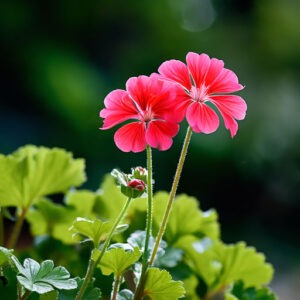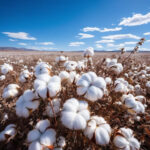Geranium, scientifically known as Pelargonium graveolens L. Herit, is a plant of significant cultural importance, known for its aromatic properties and essential oil. This guide aims to provide a detailed overview of geranium cultivation, covering various aspects such as soil requirements, pruning methods, harvesting practices, and suitable varieties for optimal yield.
1. Introduction to Geranium Cultivation
Geranium, also known as Scented Geranium, belongs to the Geraniaceae family and is renowned for its essential oil, prized for its intense rose-like fragrance. It holds cultural significance in various regions, known as Geranium in Hindi, Pannir soppu or Pannir patre in Kannada, and simply Geranium in Tamil.
2. Soil and Climate Requirements
Geranium thrives in well-drained soils, making saline or alkaline soils with poor drainage unsuitable for its cultivation. It flourishes in mild climates with low humidity, warm winters, and mild summers, with an annual rainfall ranging from 100 to 150 cm. Successful cultivation has been observed within altitudes ranging from 1000 to 2100 meters. Varieties such as Algerian and Reunion are particularly suitable for areas with heavy rainfall.
3. Varieties of Geranium
Several varieties of geranium have been identified, including KKL-1, Sel-8, Hemanti, Bipuli, and Kunti. Algerian and Reunion varieties are recommended for regions experiencing heavy rainfall.
4. Propagation Techniques
Geranium is propagated vegetatively through cuttings due to the absence of seed setting. Terminal cuttings of approximately 20 cm in length, comprising about 8 nodes, are taken from healthy plants. After trimming the leaves, the cuttings are treated with a 0.1% Benlate solution and planted in nursery beds at 5 cm spacing. The optimal time for raising the nursery is from November to January. Rooting of cuttings typically takes about 2 months, although mist conditions can expedite the process to around 20 days.
5. Plant Protection Measures
Geranium plants are susceptible to various pests and diseases, including aphids, spider mites, whiteflies, and tobacco budworms. Common preventive measures involve spraying with neem oil or spinosad. Termites and wilt are major concerns, with control methods including the application of Heptachlor to the soil.

6. Pruning Methods
While geraniums do not require extensive pruning, deadheading is essential during the blooming season to remove wilted flowers and encourage new growth. Pinching the growing tips of young geraniums can also help shape their growth.
7. Harvesting Practices
Geranium is typically ready for harvest approximately 4 months after transplanting, indicated by light green leaves and a shift in fragrance from lemon-like to rose-like. Harvesting involves cutting the green leafy shoots with a sharp sickle and immediately proceeding to distillation. With proper care, geranium plants can yield three harvests per year, with an estimated yield of 15 tonnes of fresh herbage per hectare annually, resulting in approximately 18 kg of oil through distillation.
Conclusion
The cultivation of geranium, scientifically known as Pelargonium graveolens L. Herit, offers a rewarding opportunity for farmers and enthusiasts alike. This aromatic plant, also known as Scented Geranium, is valued for its essential oil, which is prized for its intense rose-like fragrance.
Geranium cultivation requires careful attention to soil and climate conditions. It thrives in well-drained soils and mild climates with low humidity, warm winters, and mild summers. Varieties such as Algerian and Reunion are particularly suitable for regions with heavy rainfall.
Propagation of geranium is done vegetatively through cuttings, as the plant does not set seeds. Rooting of cuttings takes about 2 months, and mist conditions can expedite this process to around 20 days.
With proper care, geranium plants can yield three harvests per year, with an estimated yield of 15 tonnes of fresh herbage per hectare annually, resulting in approximately 18 kg of oil through distillation.
In conclusion, cultivating geranium can be a fulfilling endeavor, offering not only the valuable essential oil but also the joy of tending to a plant with significant cultural and aromatic importance. Its applications in cosmetics and perfumery make it a valuable addition to any garden or farm.
Click Here For Planting Techniques and Tips
FAQs
- Can geranium be grown in containers? Yes, geraniums can be grown in containers, provided they have adequate drainage and receive sufficient sunlight.
- What is the best time to plant geranium cuttings? The optimal time for planting geranium cuttings is from November to January.
- How often should geranium plants be watered? Geraniums prefer well-drained soil and should be watered when the top inch of soil feels dry to the touch.
- Are geraniums prone to any specific diseases? Geraniums are susceptible to pests like aphids, spider mites, and diseases like wilt and termites. Regular inspection and preventive measures are essential.
- Can geranium essential oil be used for medicinal purposes? Yes, geranium essential oil is known for its medicinal properties and is used in aromatherapy for its relaxing and stress-relieving effects.
Get Access Now: https://bit.ly/J_Umma










